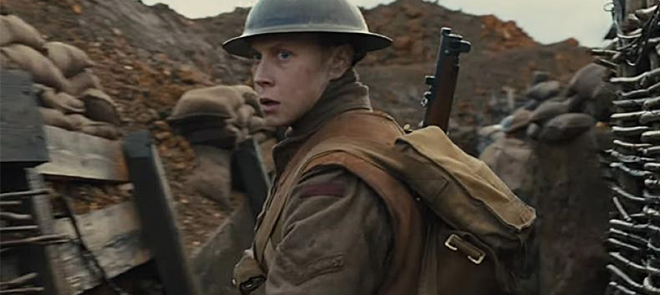Film In Review: 1917
Published February 3, 2020


Film In Review: 1917
We are pleased to introduce our new resident film writer, Jim Norman, who will be bringing you insightful previews of upcoming films at Studio 74. Alongside his existing blog, On Film, these new articles will delve into the programme of our independent cinema to offer new perspectives.
Sam Mendes’ war epic is a superb achievement in visual storytelling. Working closely with cinematographer Roger Deakins, Mendes reupholsters the war genre by employing a ‘one shot’ structure to a conventional narrative. By providing no visible cuts, 1917 ensures that we are at the soldiers’ side every step of their journey. Saving Private Ryan’s plot meets Gravity levels of immersion, metaphorically providing the audience with a helmet and rifle and sending them out into no-man’s land.
“Saving Private Ryan’s plot meets Gravity levels of immersion”
The story – just one of the ten Oscar nominations that the film has received – follows two young Lance Corporals, Schofield (George MacKay) and Blake (Dean-Charles Chapman), as they embark on a seemingly impossible mission across enemy lines to deliver a message. The message has the potential to save the life of Blake’s brother, one of the 1,600 British soldiers who will be walking into a trap if the two should fail their mission. Mendes’ film is a race against time, in which we are painfully aware of the ticking clock that hangs over the battlefield.

This is a simple story from objective to objective, with the path between the two a cacophony of bombshells, snipers and corpses. A spattering of famous faces provide a ‘best of British’ progression from point A to point B, marked by constant reminders of death at every turn.
“Deakins’ cinematography is truly the star of the picture”
Deakins’ cinematography is truly the star of the picture, acting not so much as the icing on the cake, but as the base ingredients without which the cake would fail to rise. The ‘single shot’ format works perfectly for this narrative in which time is so crucially of the essence. We are the third member of the assignment, provided with no information past that which is given to Schofield and Blake – the former’s all-out performance situates MacKay as one of the industry’s most promising young actors.
On top of providing a certain breathlessness to do-or-die situations, the long take also adds an element of beauty to the harsh environment of war. I found one of the most immersive takes coming not from the explosions and sprints, but rather from a moment in which the narrative pauses to show the troops gathered in song. This musical interlude is so much more than a pause in the action; it momentarily takes us away from the battlefield and into the collective arms of the soldiers, a chilling reminder that the young men were not disposable pawns, but real people with real lives.

The film is further heightened by an epic rising score from Thomas Newman, whose grandiose accompaniments provide a fitting sense of scale to the operation at hand and a feeling of closeted anguish in the film’s humane moments.
“A culmination of the shot, performances and score result in a film that is purely cinematic and is hugely benefitted by being watched on a big screen with powerful sound”
A culmination of the shot, performances and score result in a film that is purely cinematic and is hugely benefitted by being watched on a big screen with powerful sound. As a story of individual masculine heroism, it will undoubtedly succeed at the Academy Awards, and whilst the long take fails to provide a fresh take on the war, its epic scope and proportion succeeds in pulling the audience in and refusing to let them go.
1917 is screening at Exeter Phoenix’s solar-powered cinema Studio 74 until Thu 6 Feb. Find out more about the film and pick up tickets here >>
